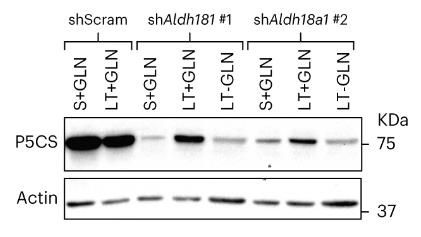Recombinant Human ALDH18A1 Protein, Myc/DDK-tagged, C13 and N15-labeled
| Cat.No. : | ALDH18A1-2882H |
| Product Overview : | ALDH18A1 MS Standard C13 and N15-labeled recombinant protein (NP_002851) with a C-terminal MYC/DDK tag, was expressed in HEK293 cells. |
- Specification
- Gene Information
- Related Products
- Case Study
- Application
- Download
| Species : | Human |
| Source : | HEK293 |
| Tag : | DDK&Myc |
| Description : | This gene is a member of the aldehyde dehydrogenase family and encodes a bifunctional ATP- and NADPH-dependent mitochondrial enzyme with both gamma-glutamyl kinase and gamma-glutamyl phosphate reductase activities. The encoded protein catalyzes the reduction of glutamate to delta1-pyrroline-5-carboxylate, a critical step in the de novo biosynthesis of proline, ornithine and arginine. Mutations in this gene lead to hyperammonemia, hypoornithinemia, hypocitrullinemia, hypoargininemia and hypoprolinemia and may be associated with neurodegeneration, cataracts and connective tissue diseases. Alternatively spliced transcript variants, encoding different isoforms, have been described for this gene. |
| Molecular Mass : | 87.3 kDa |
| AA Sequence : | MLSQVYRCGFQPFNQHLLPWVKCTTVFRSHCIQPSVIRHVRSWSNIPFITVPLSRTHGKSFAHRSELKHAKRIVVKLGSAVVTRGDECGLALGRLASIVEQVSVLQNQGREMMLVTSGAVAFGKQRLRHEILLSQSVRQALHSGQNQLKEMAIPVLEARACAAAGQSGLMALYEAMFTQYSICAAQILVTNLDFHDEQKRRNLNGTLHELLRMNIVPIVNTNDAVVPPAEPNSDLQGVNVISVKDNDSLAARLAVEMKTDLLIVLSDVEGLFDSPPGSDDAKLIDIFYPGDQQSVTFGIKSRVGMGGMEAKVKAALWALQGGTSVVIANGTHPKVSGHVITDIVEGKKVGTFFSEVKPAGPTVEQQGEMARSGGRMLATLEPEQRAEIIHHLADLLTDQRDEILLANKKDLEEAEGRLAAPLLKRLSLSTSKLNSLAIGLRQIAASSQDSVGRVLRRTRIAKNLELEQVTVPIGVLLVIFESRPDCLPQVAALAIASGNGLLLKGGKEAAHSNRILHLLTQEALSIHGVKEAVQLVNTREEVEDLCRLDKMIDLIIPRGSSQLVRDIQKAAKGIPVMGHSEGICHMYVDSEASVDKVTRLVRDSKCEYPAACNALETLLIHRDLLRTPLFDQIIDMLRVEQVKIHAGPKFASYLTFSPSEVKSLRTEYGDLELCIEVVDNVQDAIDHIHKYGSSHTDVIVTEDENTAEFFLQHVDSACVFWNASTRFSDGYRFGLGAEVGISTSRIHARGPVGLEGLLTTKWLLRGKDHVVSDFSEHGSLKYLHENLPIPQRNTNTRTRPLEQKLISEEDLAANDILDYKDDDDKV |
| Purity : | > 80% as determined by SDS-PAGE and Coomassie blue staining |
| Stability : | Stable for 3 months from receipt of products under proper storage and handling conditions. |
| Storage : | Store at -80 centigrade. Avoid repeated freeze-thaw cycles. |
| Concentration : | 50 μg/mL as determined by BCA |
| Storage Buffer : | 100 mM glycine, 25 mM Tris-HCl, pH 7.3. |
| Gene Name | ALDH18A1 aldehyde dehydrogenase 18 family member A1 [ Homo sapiens (human) ] |
| Official Symbol | ALDH18A1 |
| Synonyms | ALDH18A1; aldehyde dehydrogenase 18 family, member A1; GSAS, PYCS, pyrroline 5 carboxylate synthetase (glutamate gamma semialdehyde synthetase); delta-1-pyrroline-5-carboxylate synthase; P5CS; delta1-pyrroline-5-carboxlate synthetase; aldehyde dehydrogenase family 18 member A1; delta-1-pyrroline-5-carboxylate synthetase; pyrroline-5-carboxylate synthetase (glutamate gamma-semialdehyde synthetase); GSAS; PYCS; ARCL3A; MGC117316; |
| Gene ID | 5832 |
| mRNA Refseq | NM_002860 |
| Protein Refseq | NP_002851 |
| MIM | 138250 |
| UniProt ID | P54886 |
| ◆ Recombinant Proteins | ||
| ALDH18A1-435H | Recombinant Human ALDH18A1 Protein, GST-tagged | +Inquiry |
| ALDH18A1-5405Z | Recombinant Zebrafish ALDH18A1 | +Inquiry |
| Aldh18a1-1590M | Recombinant Mouse Aldh18a1 Protein, Myc/DDK-tagged | +Inquiry |
| ALDH18A1-436H | Recombinant Human ALDH18A1 Protein, GST-tagged | +Inquiry |
| ALDH18A1-2882H | Recombinant Human ALDH18A1 Protein, Myc/DDK-tagged, C13 and N15-labeled | +Inquiry |
Case 1: Linder SJ, et al. Nat Metab. 2023
Glutamine is essential for rapidly dividing cells, but how cells adapt to glutamine scarcity is not well understood. Through a screen, researchers found that ALDH18A1, which encodes the rate-limiting enzyme P5CS in proline synthesis, can be downregulated in response to glutamine deprivation. This downregulation enhances de novo glutamine synthesis, revealing a novel metabolic flexibility in cancer cells. By conserving glutamate from reduced proline production, cells can generate vital metabolites for survival and proliferation even under glutamine limitation. This discovery points to proline biosynthesis as a significant glutamate consumer and suggests targeting this pathway for anticancer therapies.

Fig1. Representative western blot of P5CS in short-term (S) versus long-term (LT) culture of shScram and shAldh18a1 MycER MEFs.

Fig2. Examples of immunostaining against P5CS and GS in gastric cancer sections.
Case 2: Kardos GR, et al. Mol Cancer Res. 2015
Melanoma cells exhibit deregulated processes, including protein production, which is not well targeted therapeutically. Proline biosynthesis is upregulated in melanoma and represents a potential therapeutic target. An RNAi screen identified aldehyde dehydrogenase 18 family, member A1 (ALDH18A1), as crucial for melanoma cell growth via proline synthesis. Inhibiting ALDH18A1, which encodes pyrroline-5-carboxylate synthase (P5CS), reduced melanoma cell viability and tumor growth. Silencing P5CS with siRNA lengthened cell-doubling time, indicating a metabolic slowdown without affecting apoptosis, autophagy, or cell cycle. This inhibition activated the protein kinase GCN2, which suppresses protein synthesis and can be counteracted by proline.

Fig1. siRNA targeting ALDH18A1 or a scrambled control was transfected into UACC 903, 1205 Lu, and A375M melanoma cell lines and FF2441 fibroblast cells.

Fig2. UACC 903 cells were transfected with siRNA-targeting ALDH18A1 or a scrambled control.
Recombinant Human ALDH18A1 Protein, also known as P5CS (Δ1-pyrroline-5-carboxylate synthase), is a protein encoded by the ALDH18A1 gene that plays a pivotal role in the biosynthesis of proline and ornithine. This enzyme catalyzes the conversion of glutamine to Δ1-pyrroline-5-carboxylate (P5C), which is then used to synthesize proline, an essential amino acid for cellular function and structure. Dysfunction of ALDH18A1 is associated with metabolic disorders such as hypoprolinemia and certain neurodegenerative diseases.
In research, ALDH18A1 is utilized to study proline metabolism to understand amino acid processes and related disorders, as well as to investigate cellular osmoregulation since proline acts as an osmoprotectant under osmotic stress. It is also crucial in disease research for analyzing metabolic disease models related to ALDH18A1, such as exploring the molecular mechanisms of hypoprolinemia, and assessing the potential impacts of ALDH18A1 dysfunction in neurodegenerative diseases. Furthermore, it is used in gene function studies to examine its role in biological processes like cell growth and apoptosis, and to analyze its structure-function relationships for drug design. In drug development, it aids in creating potential gene or enzyme replacement therapies for pathological states related to ALDH18A1 and in high-throughput screening for drug molecules that may affect its activity. Additionally, it serves as a laboratory reagent for assessing enzyme activity in specific metabolic pathways and for developing methods to detect and analyze ALDH18A1 expression levels in cellular or tissue samples.

Fig1. Reprogramming of proline metabolism in liver tumor. (Zhaobing Ding, 2021)
Not For Human Consumption!
Inquiry
- Reviews
- Q&As
Ask a Question for All ALDH18A1 Products
Required fields are marked with *
My Review for All ALDH18A1 Products
Required fields are marked with *
Inquiry Basket


